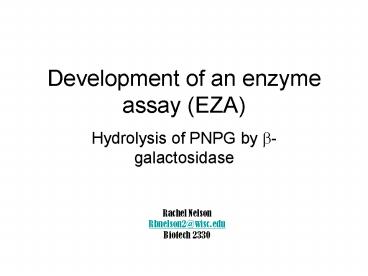Development of an enzyme assay EZA - PowerPoint PPT Presentation
1 / 28
Title:
Development of an enzyme assay EZA
Description:
Progress Curves. Determine initial slope of reaction curve ... You will need to convert from A400 to international units for your lab write-up. ... – PowerPoint PPT presentation
Number of Views:518
Avg rating:3.0/5.0
Title: Development of an enzyme assay EZA
1
Development of an enzyme assay (EZA)
- Hydrolysis of PNPG by ?-galactosidase
Rachel Nelson Rbnelson2_at_wisc.edu Biotech 2330
2
Goals
- Improve techniques
- Learn how to set up an activity assay
- Get data you can work with
- Think like a scientist - designing your own
experiment
3
Lecture overview
- Background
- Lab Protocols
- Lab advice
- Lab write-up guidelines
4
E. coli ?-Galactosidase
- Hydrolyses lactose
- 1021 residues per protein
- Quaternary structure is a symmetrical tetrad
- reporter constructs - i.e. blue/white screening
5
Reactions Catalyzed
6
Spectrophotometry
7
Enzyme assays
- Enzyme assay method to detect and quantitate
the presence of an enzyme - Often used to determine the purity of an enzyme
- Used to determine mechanism and kinetic
parameters of a reaction - Features of a good assay
- Fast, convenient, and cost effective
- Quantitative, specific, and sensitive
8
Factors affecting an assay
- pH
- Temperature
- Buffer
- Cofactors
- Inhibitors
- Activators
- Other substrates
- Allosteric effects
- Stabilizing agents (detergent, salt, reducing
agent, etc)
9
Types of assays
- Time resolved
- continuous
- Single point (fixed time) assay
- Incubate each sample with substrate for a fixed
time - Quench rxn and detect product formation
10
Designing a fixed time assay
- Choose a high substrate concentration so the S
does not change appreciably over the course of
the reaction - Pick a random (relatively high) enzyme
concentration - Monitor product formation as a function of time
- Want a point such that DP/Dt V0
11
Creating a progress curve
1. Mix E S 2. Remove at various time points
and quench 3. Measure product formation
(A400) 4. Plot A400 (y-axis) vs. time (x-axis)
12 mL PNPG solution
4 mL b-gal solution
1 M Na2CO3
Blank
1 min
2 min
3 min
4 min
6 min
8 min
10 min
12
Quenching the reaction
- Na2CO3 is basic
- Addition of Na2CO3 raises the pH to gt10
- High pH
- Stops the enzyme reaction
- Coverts p-nitrophenol to p-nitrophenolate
(absorbs light at 400 nm) - pKa 7.15
13
Progress Curves
- Determine initial slope of reaction curve
- Ratio of reaction slope to ideal slope will give
a dilution factor for using the maximum range of
the spec
14
Calculating the dilution factor
- Ideal slope 0.09
- real slope 0.369
- DF real slope 0.369/0.09 4.1 4
ideal slope - Dilute 1 part enzyme in 3 parts buffer
15
Underestimating initial activity using a
fixed-time assay
measured rate, not the initial rate!
16
Single measurement to check your dilution factor
1
found
A400
ideal
10
Time (minutes)
May have to run a couple dilutions to find the
right one. Anything between 0.75 to 1.0 is
okay Please check with me before diluting
the rest of your enzyme!!!
17
Designing a fixed time assay - Part 2
- Demonstrate the valid range of the assay by
varying the E and showing that product
formation ? to E over the entire range -
Validation Run
18
Validation runs
- Choose 3 (or more) different volumes of diluted
enzyme - Mix substrate and diluted enzyme at 1 minute
intervals - 2. Quench each after 10 minutes
- 3. Observe A400
1
A400
You will need to convert from A400 to
international units for your lab write-up.
.1
.2
.3
.4
0.5
mL of enzyme
19
Enzyme Kinetics
- How can I determine kinetic parameters for my
enzyme? - Michaelis-Menten plots - vary S with E
constant and visually determine Km and Vmax
20
Michaelis-Menten Theory
- Assumption 1 S gtgt E
- Assumption 2 ES state is in equilibrium with ES
state - Velocity of reaction is measured at varying S
until Vmax is reached - Drawbacks assymptotic relationship only allows
for visual estimation of Vmax and Km - What is Km?
21
Eadie-Hofstee Plot
22
Determining Kinetics
- Design an experiment to create a Michaelis-Menten
plot for your enzyme - Choose appropriate volume of diluted enzyme
- Choose 5 (or more) appropriate substrate
concentrations - Perform all reactions in triplicate
23
Determining Kinetics
- Be careful when choosing your substrate
concentrations!
24
Practical Tips
- Label clearly all test tubes, pipets, and beakers
at the beginning - Mix all reactions thoroughly but gently
- Timely quench the reactions
- Do not hold tube in your hand
- Pipet precisely
- Beware of contamination
- Warm up spectrophotometer for 10 minutes.
- For parts 4 and 5 stagger the start times of each
reaction by 15s to 1min according to your comfort
25
Use appropriate blanks
- What should you add in a blank?
- Order matters!
- add enzyme last
26
Lab write-up
- Beers law Aebc
- A absorbance (400 nm)
- e extinction coefficient
- b path length (typically 1cm)
- c concentration
- International units (IU, or U)
- U mmol/min (conc.)(vol)/(time)
- U/mL slope of your validation plot
- Volume activity U/mL
- Specific activity U/mg
- Q-test see statistics textbook
- Eadie-Hofstee plot see Enzymology textbook
27
Calculate absorbance values for continuous assay
- Henderson Hasselbach
- pH pKa log A-
- HA
- A- phenolate
- HA phenol
- Remember to correct for dilution
28
Things to bring
- Calculator
- Lab book











![Multiplex Assay Market Seeking New Highs- Current Trends and Growth Drivers [2019-2026] PowerPoint PPT Presentation](https://s3.amazonaws.com/images.powershow.com/9678926.th0.jpg?_=20211101041)



















